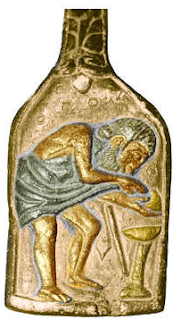 Clay model of a sheep’s liver used for instruction in liver divination in a Babylonian Temple School, c. 2000 B.C. | The ancient world offered many ways of telling the future and divining the will of the gods. In second-millennium B.C. Mesopotamia, oracle-priests would ritually sacrifice an animal and read it's entrails (extispicy). The priests chose to inspect a sacrificed animal’s liver, which was deemed the location of the soul. Divining by inspecting the liver was called hepatomancy. |  |
 | In Ancient Rome, a haruspex was a person trained to practice this form of divination. On behalf of the person who brought the animal to the temple, the priests asked the gods a question; the gods inscribed the answer in the entrails. Over the centuries, liver models became popular across the ancient Near East, from Assyria to Babylonia, Anatolia to Cyprus. |

No comments:
Post a Comment